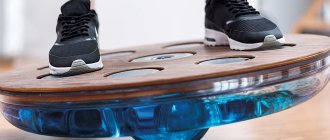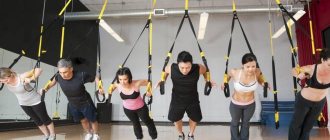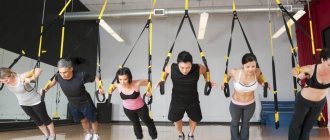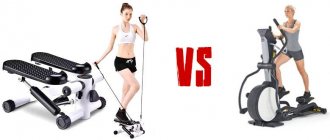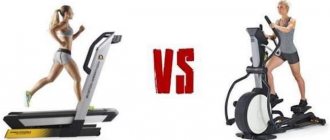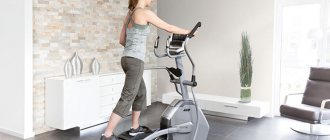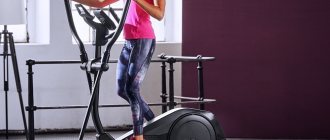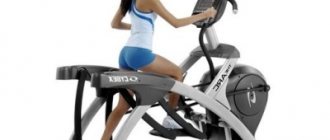An elliptical trainer is a cardio machine that combines the features of a treadmill, exercise bike and stepper. It is also called an orbitrek or an ellipsoid.
Thanks to its high efficiency, high-quality load of all muscle groups and gentle effects on joints, the elliptical very quickly conquered the market and became one of the most popular home exercise equipment. Let's take a closer look at the characteristics and features of an elliptical trainer for home workouts.
Elliptical trainer: general information
The elliptical trainer (or orbitrack) appeared in the 90s of the 20th century, when the popularity of fitness and home workouts was rapidly gaining momentum. The main advantages of the ellipsoid are high functionality, efficiency and safety. What makes it special? The ellipsoid includes the upper and lower parts of the body, having a comprehensive effect on all the muscles of your body. Thanks to the movable handles, you synchronize movements between your arms and legs and evenly distribute the load between muscle groups.
Training on an elliptical is similar in movement to running or skiing, but unlike running, the load on it is safe for the joints and spine. The foot does not leave the pedal surface at all stages of movement, which helps to avoid shock loads. The pedals move along the trajectory of an ellipse, while the legs are slightly bent: this makes the workout comfortable and safe for the knee and ankle joints. Exercises on this universal simulator will bring you a minimum of harm and maximum benefit.
What is an ellipsoid used for? Firstly, it is convenient to perform cardio workouts to burn calories and fat, so the orbitrek will be useful to anyone who wants to lose weight. Secondly, this is an excellent alternative to physical activity without leaving home. Exercises on an ellipsoid will replace your morning jogging, race walking, cycling and skiing, and group training in fitness rooms. Thirdly, it is an excellent workout for the muscles of the upper and lower body, as well as training the heart muscle.
Pros of the elliptical trainer:
- Regular training on an elliptical strengthens the heart muscle, trains the respiratory system, improves the functioning of the cardiovascular system, and develops endurance (by 20-30% after a month of training).
- Training on an elliptical is very energy-intensive: you will burn calories, speed up your metabolism, increase blood circulation and break down fats. In an hour of intensive exercise you can burn up to 800 kcal.
- Elliptical training does not have a negative impact on the leg joints and spine, unlike treadmills, exercise bikes and jumping training.
- Classes on the orbit track include all muscle groups: arms, back, buttocks, thighs, legs. The elliptical is especially effective for girls who want to lose weight in their legs - the lower part of the body receives the heaviest load.
- The ellipsoid ensures a stable body position on the simulator due to additional support on the arms and even distribution of the load between the upper and lower parts of the body. This minimizes the risk of injury and damage.
- Movements on the elliptical trainer are absolutely physiological and natural. You do not need to learn special techniques for the classes to be comfortable and safe - the range of movements is preset from the very beginning.
- This is an ideal exercise machine for those who do not like running and jumping. Elliptical training can be compared to skiing, so it is suitable even for overweight and elderly people.
- A properly functioning elliptical trainer is virtually silent, unlike some other machines. This is especially important if there are small children in the apartment or restless neighbors.
- Ellipsoids provide the ability to move not only forward, but also backward. This exercise helps to engage even more muscles, which means training the body even more effectively.
- Orbitrek has practically no restrictions on the level of training: both beginners and experienced students can train with it, regardless of gender and age. This unique exercise machine is suitable for the whole family!
Thanks to their versatility and functionality, ellipsoids have confidently taken top positions in the range of sports training equipment. In terms of their demand, they are second only to treadmills. Almost every fitness room is equipped with elliptical trainers, and more and more people are buying orbitracks for exercise at home.
Cons of the elliptical trainer:
Despite the number of advantages of the ellipsoid and its benefits for improving physical fitness at home, one cannot fail to note several disadvantages that can have a decisive role in the issue of purchasing an elliptical trainer.
- The ellipsoid has a fairly high cost: the price of a high-quality simulator starts from 20,000 rubles. Inexpensive models of lower cost do not always meet quality requirements.
- It is almost impossible to do interval training on an ellipsoid due to the characteristic smoothness of the movements of the simulator. In addition, classes on the orbitrack may seem monotonous and monotonous.
- Inexpensive ellipsoid models can squeak a lot. Moreover, even constant lubrication of materials does not always solve the problem.
- You need to allocate space in your apartment for the simulator. Sometimes you have to purchase an additional mat to prevent it from slipping. In addition, the ellipsoid is inconvenient to transport if you move often.
- The level of load in the elliptical is largely regulated by the strength of your resistance. While on a treadmill, for example, you can change the speed of rotation of the belt or incline, thereby adjusting the load more precisely and obviously.
Like any exercise machine, the orbitrek has a number of features and disadvantages that may make you doubt the purchase of this sports equipment. Nevertheless, the elliptical remains the most preferred cardio exercise machine for exercisers due to its safety and low-impact load.
Contraindications for training on an elliptical
Despite the safety of exercising on an elliptical trainer, you need to remember that this type of fitness is still considered serious physical activity. If you have any chronic or acute illness, additionally consult with your doctor about the possibility of training. Exercises on an ellipsoid during pregnancy and the postpartum period are also advisable only after the approval of a doctor.
Elliptical training is not recommended if you have the following diseases:
- Cardiovascular failure
- Angina, tachycardia
- Frequent hypertensive crises
- Oncological diseases
- Diabetes
- Thrombophlebitis
- Infectious diseases
- Serious diseases of the bones and spine
Since the ellipsoid is most often purchased for home training, you will have to independently monitor your well-being during exercise. If you feel severe shortness of breath, lack of air, dizziness, nausea, pain in the heart or behind the sternum, then it is better to stop the workout. Walk around the room at a leisurely pace for a few minutes to get your heart rate up.
Who shouldn't do it?
Listen to your own feelings during exercise.
Working out on an elliptical trainer is one of the safest cardio exercises. However, in some cases, cardio exercises themselves are contraindicated. As a rule, people with relevant diseases themselves know what they can and cannot do, but just in case, we will provide a list of restrictions.
Like any other cardio workout, training on an elliptical trainer is contraindicated if:
- heart diseases: heart failure, angina pectoris, tachycardia and others;
- regularly occurring edema;
- thrombophlebitis;
- severe forms of diabetes and cancer.
In addition, intensive exercise is prohibited during infectious diseases.
We recommend (even if you are an absolutely healthy person) to always focus on your subjective feelings and always consult with qualified specialists (doctor and trainer).
Ellipsoid for weight loss
The main question that interests those losing weight when choosing an elliptical trainer is: does it help you lose weight? Of course, like any cardio machine, the elliptical is effective for weight loss. Firstly, training on the orbit track provides additional calorie consumption. Secondly, regular exercise does not contribute to a faster breakdown of fats in the body.
Nutrition during training on the elliptical
But first, it’s worth emphasizing once again that the process of losing weight occurs when you consume fewer calories than you burn. Without dietary restrictions, losing weight will be difficult even with regular exercise. If you are not yet ready to radically change your menu, you can simply follow the general advice that underlies the principles of proper nutrition.
General nutrition tips:
- Eliminate industrial sweets, sugar, fast food, and flour products from your menu.
- Give preference to boiled and baked foods
- Drink 1.5-2 liters of water a day, this dulls the feeling of hunger
- Include more fresh vegetables and fruits in your menu (you should not overuse bananas and grapes as fruits)
- Try to eat small meals 5-6 times a day
- Don't forget about breakfast and don't skip dinner (about 3 hours before bedtime)
- Consume enough protein in food: meat, fish, cottage cheese, legumes, eggs (about 2 g of protein per 1 kg of weight)
- Fast carbohydrates are best consumed in the morning
Muscle work during training on an elliptical
The big advantage of the ellipsoid compared to other exercise machines is that it works the muscles of the upper and lower body simultaneously. For example, during exercise on a treadmill and exercise bike, the muscles of the legs and buttocks are mainly worked. Orbitrek also gives a load to both the leg muscles and the arm muscles. And the more muscles are activated during training, the more calories are burned. In addition, this makes the load on the body more uniform and of higher quality.
What muscles work during training on the elliptical:
- Anterior thigh muscles (quadriceps)
- Muscles of the back of the thigh (biceps femoris)
- Gluteal muscles
- Deltoids (shoulders)
- Biceps and triceps (arms)
- Latissimus dorsi and trapezius
- Psoas muscles
- Rectus abdominis muscle
Please note that muscles do not grow from training on an elliptical trainer. They will tone up a little, the relief will appear due to a decrease in the fat layer, but there will be no increase in muscle mass from exercising on a cardio machine. This is simply impossible. If you want to build muscle and increase mass, then you need to do strength training with heavy weights.
By the way, the elliptical trainer uses the abdominal muscles to a lesser extent, so you can work on them additionally. For example, you could add a 10-minute core session after your cardio workout. Check out our selection: Top 50 exercises for abdominal muscles.
Is the elliptical trainer effective for weight loss?
Let's look again at the effectiveness of the elliptical trainer for weight loss. It is important to note that you cannot lose weight from exercise alone! An integrated approach is required: training + nutrition. Moreover, 80% of success depends on nutrition. However, training is an important component. Regular fitness helps tone your muscles (this makes your body firm and toned) and helps you burn extra calories (which means you will lose weight faster, all other things being equal).
In an hour of training on the elliptical, you can burn 400-800 kcal, depending on the intensity of the exercise and your level of physical fitness. The more advanced you are, the fewer calories you will burn per session. Therefore, do not forget to increase the load as your endurance and muscle strength increase.
10 tips for training on the elliptical:
- Always exercise on the elliptical in sports shoes (preferably running sneakers) and comfortable sportswear made from natural materials. Don't forget to ventilate the room before training.
- You can exercise on an elliptical trainer at any time of the day; this does not affect its effectiveness. Choose a time that is convenient and comfortable for you.
- Before training, be sure to do warm-up exercises for the whole body, and after training, stretching to avoid clogged muscles and soreness.
- Drink a glass of water 15 minutes before your workout and a glass of water 5 minutes after you finish your workout. During your workout on the elliptical, be sure to drink water: one or two sips every 5-10 minutes of exercise.
- Do not eat at least 1.5 hours before training (a light snack can be 45 minutes before). If you work out in the morning on an empty stomach, training on the elliptical trainer should not last more than 40 minutes.
- Within half an hour after training, have a small meal that consists of protein and carbohydrates. For example, cottage cheese + apple, chicken breast + vegetables or protein shake.
- To achieve effective results, training must be regular. Don't expect rapid weight loss after 2-3 weeks of exercise. The first noticeable results can be seen after 2-3 months (this applies to any training, not just on the ellipse).
- If you consume more calories per day than your body can burn, then you will not lose weight even with daily intense training (or you will, but very slowly). Nutrition control is a must if you want to burn fat!
- We recommend combining elliptical training with regular strength training. This will help tighten your body and speed up the fat burning process. It is better to exercise on an elliptical after strength training or distribute it over different days.
- If you want to put extra stress on your legs or just make your elliptical workout more challenging, you can wear leg weights or a resistance band.
Ellipse training plan
You can create a workout plan on the elliptical trainer yourself or consult a fitness trainer. We offer several principles for training on the ellipse that you can follow.
How long to train on an elliptical for weight loss:
- For beginners: 3 times a week for 20 minutes
- For intermediate level of training: 4 times a week for 30-40 minutes
- For advanced training: 4-5 times a week for 45-60 minutes
How long to train on the elliptical to stay in shape:
- For beginners: 2 times a week for 20 minutes
- For intermediate level of training: 2-3 times a week for 30 minutes
- For advanced training: 3 times a week for 45 minutes
What should your heart rate be while exercising on an elliptical trainer? Beginners can train at an average heart rate (heart rate) of 110-120 beats. To calculate your heart rate, use the built-in sensors, which are usually located on the handles of the ellipsoid. If you want to get more accurate values, it is better to purchase a fitness bracelet or heart rate monitor. You can also measure your pulse manually using a stopwatch, but this is not always convenient.
How to calculate the optimal heart rate zone? To do this, use the formula: Maximum heart rate = 220 minus your age. For an effective workout, you need to train in the zone of 70-80% of your maximum heart rate. For example, your age is 35 years old. This means that maximum heart rate = 220 – 35 = 185 beats per minute. Accordingly, an effective cardio workout for fat burning will take place at a heart rate of 130-148 beats per minute (0.7*185 and 0.8*185).
Read more in the article on cardio training.
Interval training plan on the elliptical (for burning fat):
- First 10 minutes: easy walking at an increasing pace for 10 minutes (heart rate in the 50-60% zone)
- Main part: alternating low-intensity intervals for 4-5 minutes (heart rate in the 60% zone) and high-intensity intervals for 1-2 minutes (heart rate in the 80% zone)
- Last 5 minutes: Slow walking to restore heart rate
Moderate training plan on the elliptical (to develop endurance):
- First 10 minutes: easy walking at an increasing pace for 10 minutes (heart rate in the 40-50% zone)
- Main part: fast walking in the heart rate zone of 50-60%
- Last 5 minutes: Slow walking to restore heart rate
If you want to turn off the use of your hands while practicing on the orbit track, you can hold on to the static handles without moving them. In this case, the muscles of the legs and buttocks will receive a stronger load.
What muscles work on the elliptical?
To be precise, the ellipsoid imitates Nordic walking. For those who don’t know, this is a type of walking in which you hold sticks in your hands and, as it were, push off with them from the surface on which you are walking.
Only the ellipsoid has a nuance - when you pull these sticks towards you, the pedals also move after them. Thus, the elliptical trainer allows you to work the muscles of almost the entire body. And to be more precise:
- The hands pull and push the “sticks”, the shoulder girdle works. The back and chest also participate in the movement of the “sticks” or handles.
- The legs press the pedals, the hips and buttocks work.
- The core muscles provide stability to the entire body.
What is the best cardio equipment to buy?
An ellipsoid, a treadmill, an exercise bike, and a stepper are the most popular options for cardio equipment at home. Each of them has its own advantages and disadvantages, which individually influence the buyer’s choice. Recently, the ellipsoid has become popular among those who train at home, due to its effectiveness and functionality. But let's once again note the features of each of this cardio equipment.
Ellipsoid
From the point of view of safety for the joints and spine, the elliptical is the most preferable exercise machine. It is designed taking into account minimal impact on the joint-ligamentous and musculoskeletal system, so you can exercise on the orbitrek without harm to your health even if you are overweight and have no fitness experience. This is achieved thanks to a stable body position, additional support and a given range of motion. An elliptical machine makes it difficult to fall or make awkward movements, unlike a treadmill where you constantly need to be focused on your body position.
However, classes on the orbitrek are quite monotonous. Inexpensive models practically eliminate the possibility of interval training and minimize load variability. If on a treadmill you can easily set the desired speed and incline angle, then on an ellipsoid the load level will all depend on the applied resistance force. In terms of load intensity, the elliptical is superior to an exercise bike, but inferior to a treadmill.
Treadmill
A treadmill is more suitable for athletic and healthy people without serious problems with joints and spine (although modern expensive models of treadmills are equipped with a special coating that reduces impact loads). Here you have a wider range of loads: from simple walking to intense interval running. In addition, the load level can be adjusted using the angle of inclination. With a treadmill, you will have virtually no limit to your workload, which is why this machine is great for athletes as well. Average calorie consumption while running on a treadmill: 600-1100 kcal per hour, on an elliptical trainer: 400-800 kcal per hour.
One of the disadvantages of the treadmill is its impressive size. The elliptical is a more compact and lightweight exercise machine (folding models are also available). In addition, the treadmill mechanism is quite noisy and consumes more energy. From a safety point of view, this simulator is also not a reference. Falling on a moving treadmill is not that uncommon, while falling on an elliptical is virtually impossible.
Exercise bike
An exercise bike is an ideal exercise machine from a home fitness point of view. Judge for yourself, you can pedal while watching TV series or reading books. For example, this is not always possible with elliptical training because it requires more concentration. Also, the exercise bike is more compact in size and does not take up much space in the apartment. In addition, the cost of exercise bikes is on average lower than the cost of an ellipsoid and a treadmill.
One of the disadvantages of an exercise bike is the uneven distribution of the load. While pedaling, you'll be putting a lot of stress on your legs, leaving your upper body unattended. Also, exercise on an exercise bike puts a traumatic load on the knees, so if you have problems with your joints, it is not advisable to pedal on the exercise bike. Separately, it is worth mentioning the load. Firstly, an exercise bike involves fairly monotonous and monotonous workouts. Secondly, in terms of the number of calories burned, its effectiveness is lower than when exercising on an elliptical and treadmill.
Stepper
The stepper as an alternative to the above-mentioned simulators can only be considered conditionally. Among the undoubted advantages of the stepper it is worth noting its very compact size, ease of transportation and low price. You can purchase such a simulator if you are looking for an option from the “cheap and cheerful” series. But if you want to buy a full-fledged cardio machine, then a stepper is unlikely to cope with the task.
Firstly, the stepper offers a very limited load. In essence, this is just walking, which uses exclusively the muscles of the lower body. Secondly, the intensity of the load is much lower: in an hour of training on a stepper you can burn a maximum of 500 kcal. Thirdly, during training on the stepper there is a strong load on the ankle joint, which can subsequently lead to pain and injury. Therefore, a stepper cannot be seriously considered as an alternative to an elliptical trainer.
Ideally, you should try each cardio machine before purchasing in order to have an idea of the comfort of the workout and the load that suits you. If you have the opportunity, do a trial session in the fitness room before purchasing a machine, so as not to make a mistake in your choice.
Recommendations before starting classes
The simulator is a working tool. Don't turn it into a hanger or cat bed.
To make the load easier to bear, build on your habits. If you are a typical night owl, there is no point in planning an activity in the morning. If you are a morning person, then feel free to train in the first half of the day. But keep in mind that you cannot train earlier than an hour after waking up and later than 2-3 hours before bedtime.
Take five minutes and understand how the elliptical trainer works and what muscles are involved during the session. This will help you understand how to properly distribute the load and what additional exercises you need.
Don't exercise on an empty stomach. It is best to do this 1.5 hours after a light meal. If you feel very thirsty during class, rinse your mouth with water or drink a few sips. Drinking a lot of water or even snacking during intense exercise is not a good idea.
Start each workout with a warm-up to prepare your body for the stress ahead. For 5 minutes, perform squats, bends forward, backward and sideways, as well as swinging your arms.
Try to supplement your workouts with strength training. The secret of an ideal body is the harmony of the training program.
If you exercise at home, do not turn your elliptical into a clothes hanger and a cat bed. That's not why you bought it. The elliptical trainer is your friend and working tool.
How to choose an elliptical trainer
If you decide to purchase an ellipsoid, then you need to know the criteria that you need to focus on when choosing a simulator.
Type of resistance
The type of resistance is the main criterion that determines the operating principle of the ellipsoid and its price. Depending on the type of resistance, there are 3 types of elliptical trainers:
- Ellipsoids with mechanical resistance. In such simulators, movement occurs due to a belt stretched around the flywheel. Mechanical resistance does not ensure smooth movement, which means the simulator loses its main advantage - a safe load on the joints. In addition, ellipsoids with mechanical resistance are quite noisy and quickly become unusable due to the short-lived operation of the belt. Although they are the most inexpensive on the market, purchasing such exercise machines is still not recommended.
- Ellipsoids with magnetic resistance. They work due to the influence of magnets on the flywheel, which allows you to change the load in any range and provide a smooth ride without stress on the joints. Load adjustment is usually done manually. Such ellipsoids are affordable and quite popular for home use. Most often, ellipsoids with magnetic resistance operate on batteries; power is needed only for the monitor.
- Ellipsoids with electromagnetic resistance. They are the most functional type of exercise machine, so it is better to opt for it. The load in such ellipsoids is electronically regulated; they usually have ready-made training programs built into them. These models are distinguished by increased smoothness, high rotation speed, a large number of settings, low friction and low noise levels. It is convenient and effective to exercise on such a simulator, but their price is also significantly higher.
Flywheel size
The flywheel is the main part of the simulator, which ensures continuous movement of the pedals during exercise. The greater the weight of the flywheel, the smoother the movement will be, which means the load will be more effective and safer for the joints. On inexpensive elliptical models with a light flywheel, a slight slowdown will be felt at the top of the movement. In this regard, you will need to apply additional force, which harms your joints. The minimum recommended flywheel weight is 8 kg.
But it is important to note that you cannot pay attention only to the weight of the flywheel. Its functionality can only be assessed in conjunction with the overall dynamics and elements of the entire movement unit, which is inaccessible to the average user.
Rear or front drive
Depending on the location of the flywheel, there are front-wheel drive and rear-wheel drive ellipsoids. Rear-wheel drive trainers are considered a classic option; such models are the most common. In them, the flywheel and the entire resistance system are located behind the athlete. The design of rear-wheel drive ellipsoids is very convenient for practicing running with the torso bent forward and training skiing techniques.
Front-wheel drive models are a more recent development and typically cost more. What is their advantage? Front-wheel drive models have a shorter distance between the pedals (called the Q-factor), so your body will be in an ergonomically correct position during exercise. This makes the workout better and more effective, as well as safer for the joints.
Now even more modern models are sold with a central flywheel, where the distance between the pedals is minimal (the cost of such models is even higher).
Step length
This is another important characteristic that you need to pay attention to when choosing an ellipsoid. To measure step length, you need to move the pedals as far apart as possible and measure the length from the beginning of one pedal to the beginning of the second pedal. The most comfortable and convenient step length is considered to be 40 cm. This step length allows you to use a larger number of muscles and carry out a better workout. The 50cm stride length may not be comfortable for people of short to average height.
Inexpensive models offer a step length of 30-35 cm. If you are short, this step length will in principle be comfortable, but if your height is more than 175 cm, then be sure to choose a trainer with a step length of more than 40 cm. There are also models on the market that have an adjustment function step length.
Display data
It is much more convenient to control the load from the monitor. When choosing an elliptical trainer, pay attention to which indicators about the completed workout are displayed on the display. Usually you can track your current speed, calories burned, distance traveled, and rotational speed. Nowadays, even inexpensive elliptical trainers are equipped with a screen, and more expensive models even have a color display.
Heart Rate Sensors
In inexpensive models, pulse sensors are located on the handles, but in this case the measurements have a large error, which sometimes reaches up to 30%. More expensive models offer touch-sensitive heart rate sensors that transmit data to the computer wirelessly. But if you have a heart rate monitor or fitness bracelet, then this parameter is not an important factor when choosing an orbit track.
Built-in programs
It is very convenient when the elliptical trainer already has ready-made training programs that you will need to follow. For example, you can turn on a mode for effective fat burning or a mode for training your heart. It is also usually possible to create and save your own programs.
Weight Limit
Basically, ellipsoids are designed for a maximum weight of 130-150 kg. Be sure to pay attention to the exact number in the description of the simulator. It is considered optimal if the maximum allowable weight is 15-20 kg higher than the weight of the person exercising.
Additional accessories
For example, it is convenient if the exercise machine has a water holder, a book stand, a built-in ability to play music, wheels for easy transportation, floor unevenness compensators and other devices. You can also purchase a folding ellipsoid, which will take up less space in your apartment.
Which is better: an elliptical, a treadmill or an exercise bike?
The answer to this question is that an elliptical is a combination of a treadmill and an exercise bike. An elliptical is ideal for home workouts. It helps to quickly build muscle and lose weight, and does not have a large and negative effect on human joints. In general, all the advantages of this cardio machine are obvious.
Top 10 popular ellipsoid models
Now on the market there are a lot of affordable models of ellipsoids up to 20,000 rubles. However, it is important to note that the low cost of the simulator may be due to the poor quality of the material and workmanship, so the ellipse design will be fragile and unreliable. Breakdowns of elliptical trainers are not uncommon: flywheels break, pedals break off, and severe squeaks appear. Defects can also happen with expensive orbitrek models, but little-known brands and cheap models are at particular risk. When choosing an elliptical trainer, be sure to evaluate the reliability of the frame, handles, pedals, and flywheel.
Our selection: Top 20 popular ellipsoid models
Here are examples of popular models of ellipsoids of different price categories. Among the most well-known manufacturers are: Sport Elite, Body Sculpture, Kettler, Torneo, Hasttings, Oxygen, HouseFit, Life Fitness, Proxima.
Sport Elite SE-304
Oxygen Peak E
UnixFit SL 350
Carbon Fitness E304
Body Sculpture BE-6800D
Sport Elite SE-800HP
Clear Fit CrossPower CX 200
Body Sculpture BE-6700
Svensson Body Labs ComfortLine
Proxima Serenada
Ideal solution for rehabilitation
The occurrence of injuries, especially serious ones, can have a profound impact on an athlete's career. Moreover, a proper return to the world of sports, a proper and gentle restoration of muscle function, is always required. If you do something wrong or overexert yourself, you can only worsen the injury or create a completely new one.
The elliptical trainer is a great help for athletes going through a rehabilitation period. Its key advantage is the ability to cover a large area of problems, having a beneficial effect on the body. In addition to the previously mentioned effect on the cardiovascular system, a noticeable improvement in the aerobic abilities of the user’s body can be noted.
The most important thing is that the process of muscle degradation or atrophy stops - this is exactly what is so dangerous during injuries; an athlete can lose a large amount of muscle, which will make a return to professional sports impossible or take too long. It is also important that the ellipse does not put a shock load on the spinal column, and also does not have a detrimental effect on the joints: knee, ankle and hip). With the help of this simulator, an athlete can simulate various sports activities, from regular walking to climbing a mountain or fast skiing.
Types of simulators by loading method
The functionality of the ellipsoid is largely determined by the load system used in the basis of the design. There are 4 main types of simulators depending on the implemented method of loading.
Mechanical
– are driven by the user’s own efforts. This is the simplest and most inexpensive variety. Mechanical ellipses do not take up much space, are easy to use, lightweight, and do not require an electrical connection, complex maintenance or expensive repairs. The load is regulated by a special handle. Some models have a folding design. Cons: no smooth ride, no ability to select operating modes and change the load directly during training, noise appears while pedaling, the flywheel and brake pads wear out over time.
Magnetic
– designs in which the load is created due to the proximity of magnetic pads to the surface of the flywheel. In such simulators, the load can be changed directly during training (about 8 levels). Magnetic ellipsoids are often complemented by an electronic control unit. The simulator is powered by electricity or batteries. Models with a magnetic type of adjustment are compact, relatively inexpensive, do not make noise during operation and are equipped with a more advanced braking system. Such models are the best choice for those who are just starting to train.
Electromagnetic
– simulators in which the load is also created by magnetic pads. The difference is that with this design the pads remain stationary; adjustment is achieved by changing the electromagnetic field. This is a more expensive option, but it allows you to adjust the load over a very wide range and very accurately control moving systems. Electromagnetic ellipsoids are multifunctional, equipped with computers and allow you to select different training modes, the number of which can number several dozen. Some models have pulse-dependent operating modes. Electromagnetic ellipsoids are convenient and silent, but they are more expensive than others, take up a lot of space and require connection to an electrical outlet.
Aeromagnetic
– simulators, the design of which is supplemented by an electric generator. The generator receives energy from the rotation of the flywheel. The resulting charge is enough to operate the computer and the electromagnets that regulate the load. In case of long periods of inactivity, the battery is charged from the mains adapter. Aeromagnetic ellipsoids have most of the advantages of electromagnetic-type models, but are quite expensive.
Disadvantages and contraindications
The disadvantages include:
- Large dimensions and cost of the device: the device is larger than a stepper or an exercise bike, but smaller than a treadmill.
- The mode of operation on the simulator is monotonous; it is impossible to precisely regulate the speed and load, as in a treadmill. The more pressure your feet put on the pedals, the more intense the work done.
- Inexpensive devices can quickly fail due to poor quality assembly of parts. It is better to take exercise machines from well-known and reliable manufacturers.
Contraindications include:
- Any serious diseases of internal organs - heart, kidneys, diabetes.
- Acute inflammatory processes, fever.
- Diseases of the joints of the legs, especially the knee, hip, ankle.
- Thrombophlebitis of the veins of the lower extremities.
